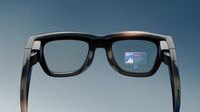Meta has thrown down the gauntlet in the race to make smart glasses a mainstream reality, unveiling its most ambitious wearable yet: the Ray-Ban Display. Announced by CEO Mark Zuckerberg at the Connect conference on September 18, 2025, these smart glasses blend classic Ray-Ban style with cutting-edge technology, promising to change the way people interact with digital information on the go. Set to hit shelves on September 30 for $799, the Ray-Ban Display is more than just a fashion statement—it’s a window into Meta’s vision for the future of personal computing.
Unlike previous iterations that focused on audio—letting users listen to music, take calls, or summon a voice assistant—the Ray-Ban Display introduces a private, right-lens screen that overlays messages, directions, photos, and Meta AI prompts directly into the wearer’s field of view. As reported by Dezeen, this heads-up display is visible only to the wearer, disappears when not in use, and is bright enough to read even outdoors. No more fumbling for your phone in the middle of a crowded street or missing a turn because you couldn’t glance at your GPS. The glasses keep things discreet and natural, making the digital world feel like a seamless extension of reality.
But Meta didn’t stop at visual innovation. The company debuted the Meta Neural Band, an EMG-enabled wristband that reads the electrical activity in the wearer’s nervous system. As described by Fast Company, this band allows users to control the glasses with subtle hand gestures—tapping fingers, turning an invisible knob, or even scribbling letters in the air to reply to messages. The technology, previewed just months ago in Nature, is being hailed as the world’s first mainstream neural interface, offering hands-free control that’s accessible even for people with limited arm mobility. The band’s construction is as advanced as its function, featuring carbon-coated electrodes and a strong yet flexible woven mesh made from Vectran fiber.
The Ray-Ban Display’s hardware is a study in thoughtful design. The glasses retain Ray-Ban’s iconic Wayfarer silhouette, only slightly scaled up to accommodate the tech, and weigh a mere 69 grams. Transition lenses automatically adjust to ambient light, morphing from clear indoors to sunglasses outside. Available in black and sand colorways and two sizes, they’re built for all-day comfort and style. As Meta emphasized, the device is not a prototype—it’s ready for mass production, a significant leap for an industry that’s struggled to deliver practical consumer smart glasses.
Functionality is where the Ray-Ban Display truly shines. The monocular display projects information into only one lens, which means no 3D graphics or AR games, but it dramatically reduces power consumption. This efficiency allowed Meta to use a smaller battery, keeping the form factor close to standard eyewear. According to Meta AR devices VP Ming Hua, “It’s really optimized for private viewing.” The device supports photo and video capture, previews, live translations, real-time subtitles, and context-aware assistance—think directions, reminders, or restaurant recommendations—all powered by Meta’s growing AI ecosystem.
During his keynote, Zuckerberg didn’t hold back on the ambition behind the product. “Our goal is to build great-looking glasses that deliver personal superintelligence and a feeling of presence using realistic holograms,” he said, coining the term ‘personal superintelligence’ to describe AI tailored to individual lives and goals. “Glasses are the ideal form factor for personal superintelligence because they let you stay present in the moment while getting access to all of these AI capabilities that make you smarter, help you communicate better, improve your memory, improve your senses and more.” Zuckerberg argued that glasses are uniquely suited to this new era—allowing AI to see, hear, and talk to you throughout the day, and soon, generate whatever UI you need, right in your vision in real time.
Meta’s focus on privacy and discretion is no accident. The company learned from the missteps of early players like Google Glass, which drew criticism for their conspicuous design and privacy concerns. As Meta CTO Andrew Bosworth put it, “People are making Google Glass comparisons to the Meta Ray-Ban Display glasses. It has a display, it’s monocular. But they’re so different because [ours] look good. [Google Glass] didn’t look good, and that matters a ton.” Analyst Anshel Sag echoed this sentiment, calling the Ray-Ban Display “a well integrated product.”
The glasses are also packed with features aimed at accessibility and convenience. Real-time transcription and translation can help people who are hard of hearing or navigating foreign environments. A teleprompter app is in development for public speakers. And with the Neural Band, users can interact with their digital world without needing to look at or touch the device—an experience that reviewers described as feeling “remarkably close to magic.”
Meta’s ambitions extend beyond hardware. At Connect, the company announced it will open up its smart glasses ecosystem to outside developers via the new Wearables Device Access Toolkit. Early partners include Twitch, which is developing livestreaming capabilities; Disney, experimenting with a theme park assistant; and 18Birdies, creating golf club recommendations. These apps leverage the built-in sensors and audio features of Meta’s glasses, and while most initial integrations target non-display models, the potential for the Ray-Ban Display is vast. The developer preview is limited for now, but broader access is expected in 2026—a move that could turbocharge innovation and keep Meta ahead of rivals.
Still, not everything is perfect. Zuckerberg acknowledged some glitches during his on-stage demonstration, blaming the venue’s Wi-Fi. And while Meta’s tight control over third-party apps may be a safeguard against privacy abuses—like the facial recognition experiments that once made headlines—it could also limit the ecosystem’s growth. As Sag noted, “The biggest way someone could compete with them is by third-party developer access and making those classes more useful, even if they’re not more fashionable.”
Meta’s partnership with EssilorLuxottica, the parent company of Ray-Ban, has been instrumental. Since their first camera-equipped smart glasses in 2021, they’ve sold over two million units, steadily refining the line. The Ray-Ban Display, with its blend of fashion and futuristic tech, feels like the culmination of years of research and iteration. It’s not a full AR headset—those are still in the works, as Meta’s Orion prototype shows—but it’s a giant leap toward ambient computing and AI-powered personal assistants woven directly into daily life.
As September 30 approaches, all eyes are on the Ray-Ban Display. Will it become the must-have wearable of 2025, or just another step in the long journey toward truly smart eyewear? One thing’s for sure: Meta has set a new bar for what’s possible, and the rest of the industry will be scrambling to catch up.


